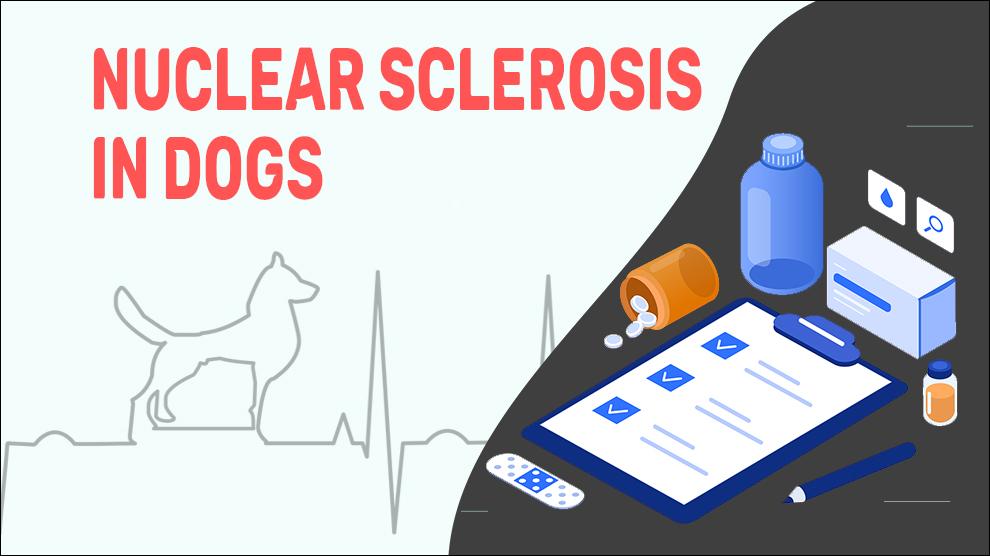Nuclear sclerosis is a type of cataract that causes the hardening and yellowing of the nucleus due to the compaction of the nuclear region of the lens. Also called Lenticular sclerosis, this results in a bluish, transparent, hazy appearance in the lens of the eye in middle-aged (over the age of 6) to senior dogs.
Fortunately, dogs don’t need reading glasses as humans do. They don’t read so they don’t have to use their close-up vision. Actually, most dogs seem unfazed by nuclear sclerosis at all. Nuclear sclerosis does not significantly affect vision in dogs.
The nuclear sclerosis etiology is still unclear. The most accepted ideology is this happens due to an age-related change. When dogs get older, the development of new fibers around the outer ring of the lens applies pressure on the older fibers in the central lens that could not leave the lens capsule. The nucleus becomes harder, denser, and more opaque. The name ‘nuclear sclerosis’ describes this development well. Sclerosis means “tissue hardening that is abnormal”, which in this instance is the nucleus of the lens.
On account of these changes, veterinary ophthalmologists think a tiny, round, gleamy grey-colored opacity or blue or grey haziness forms in the middle of the lens. You may find this when you look into the dog’s eyes or perhaps, it is easier to find out when looking at the sclerotic eye from sideways.
Symptoms Of Nuclear Sclerosis
The initial symptoms are subtle and it may take a longer time for you to notice the symptoms
- Cloudiness or blue-grey appearance of eyes
- Blurry and filmy vision
- Mild changes in vision
- Sensitivity to sunshine increases.
- Trouble seeing at night
Treatment Options For Nuclear Sclerosis
In the majority of dogs, treatment is not needed. However, as eyes are involved, it is better to get the suggestion of a veterinary ophthalmologist. Supportive therapies may be suggested, for example, food supplements can be helpful.
Home Remedies For Nuclear Sclerosis
Nuclear sclerosis condition is not improved by conservative treatment. So treatment is rarely recommended.
Prevention Of Nuclear Sclerosis
So, if you have notice that your dog’s eyes are becoming a little hazy or cloudy or has bluish tinge, but the vision seems normal, you are almost certainly have nothing to worry about.
Next time when you visit the vet, just ask him to perform an eye exam to validate the possible diagnosis of nuclear sclerosis.
Unfortunately, there is no way to prevent nuclear sclerosis and the only way available is to make sure your pet eats a healthy diet. This will strengthen your dog and also increase eye health.
Affected Breeds Of Nuclear Sclerosis
Middle Age Dogs, Senior Dogs
Additional Facts For Nuclear Sclerosis
Risk Factors of nuclear sclerosis
Morbidity:
Is Nuclear Sclerosis the Same as Cataracts in Dogs?
No. Cataracts and Nuclear sclerosis are two different eye conditions, both of which are prevalent in older dogs.
Both present similar symptoms but nuclear sclerosis is a normal age-related change that can mimic cataracts in form but is unlikely to disrupt the vision. A cataract presents itself as a cloudy or opaque change to all or part of a dog’s lens, and this interferes with the light to make its way through the dog’s retina, hampering a dog’s ability to see. On the other hand, nuclear sclerosis does not considerably impact a dog’s vision.
In ambient light,
A normal dog's lens - clear, when illuminated exhibits a greenish shine
Sclerotic lens - a smooth, shining opacity with a bluish-to-grayish tinge
Cataracts - look like wheel spokes pointing inward to the lens or small, whitish chunks of nugget ice that vary in opacity, size, and shape.
Sometimes, it can happen that a senior dog having nuclear sclerosis already can develop a cataract later on. This does not mean that nuclear sclerosis causes cataracts. There is a condition called nuclear cataract that makes the proteins in the lens clump together due to excessive protein oxidation. This hardens the eye and can cause blindness.
Nuclear cataracts can cause second sight, which means a temporary improvement in near-sight (close-up) vision. However, nuclear sclerosis doesn’t cause blindness or second sight.
Mortality:
There is no documented mortality due to this condition
Diagnosis:
- Ophthalmoscope
- Retroillumination (slit-lamp evaluation)
- Biomicroscope exam
Prognosis:
Treatment is not necessary for dogs with nuclear sclerosis because the condition does not cause a significant impact on vision. When you suspect any secondary complications to the eye, visit the vet for an eye exam.
Most of dogs develop different degrees of eye problems such as nuclear sclerosis as they get older.
When To See A Vet
It’s better to set up an appointment with your veterinarian if you notice-
- Any changes in vision
- If your dog bumps into furniture
Food Suggestions For Nuclear Sclerosis
The diet should include foods containing Vitamin C, Vitamin E, Vitamin A (beta carotene), Coenzyme Q10, Omega-3s, Lutein, and Zeaxanthin.
- Pick seafood over the usual beef and chicken
- Omega-3 oily fishes such as salmon, tuna, cod, etc
- Leafy greens such as spinach, kale, water cress, etc
- Nonmeat/plant protein sources such as nuts, Lentils, Beans, Eggs, etc
- Citrus fruits or juices
- Sweet potatoes, tomatoes, pumpkin
- Pork, tuna, Oysters
- Blueberries, Broccoli, cabbage, carrots
Conclusion
The possibility of a loss of vision for your dog cannot be ruled out, however, that is very rare. The prognosis of eye-preserving vision will not be impaired in most cases. The vision may be slightly impaired in severe cases and this can be more of an annoyance. Though it may not go away, your dog’s quality of life cannot be impaired by this condition.

















